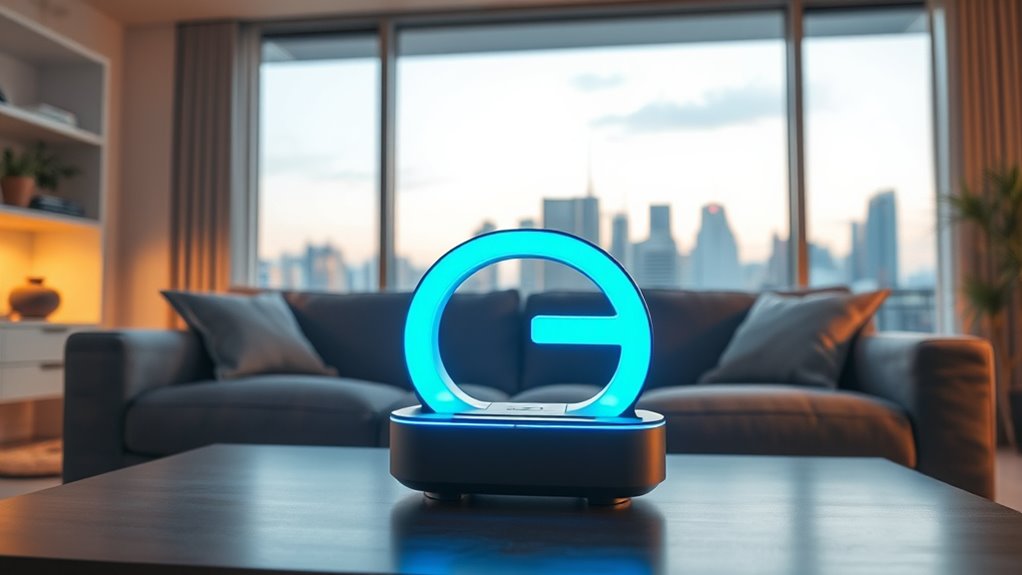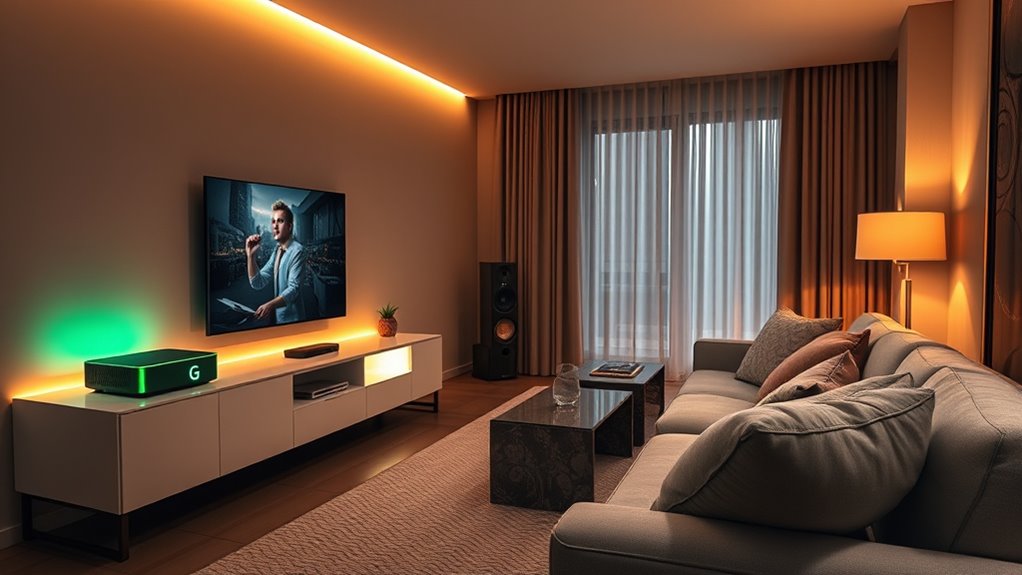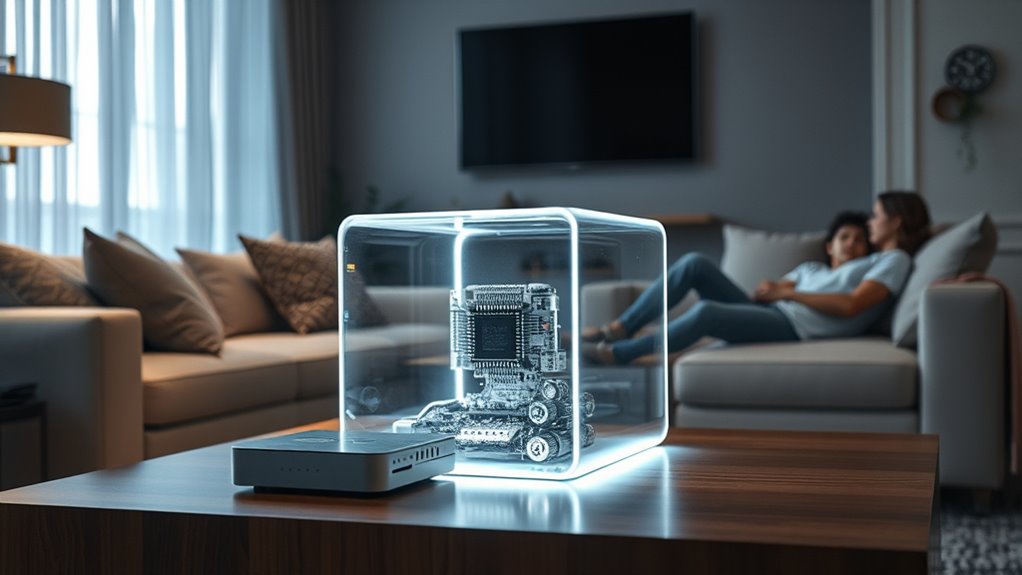5G is set to replace Wi-Fi in your living room by offering faster speeds, lower latency, and better connection stability for all your smart devices. It’s more secure and can handle multiple gadgets at once, making your home smarter and more efficient. While some challenges like device compatibility and coverage remain, ongoing advancements are speeding up adoption. Keep exploring how this new wireless tech can transform your everyday life and future-proof your home.
Key Takeaways
- 5G offers faster speeds, lower latency, and higher reliability, making it a strong candidate to replace Wi-Fi in home networks.
- It can support multiple smart devices simultaneously without performance drops, enhancing overall home connectivity.
- Advanced security features in 5G protect smart home data better than traditional Wi-Fi networks.
- Growing device compatibility and infrastructure investments accelerate the transition from Wi-Fi to 5G in homes.
- Future smart home innovations will rely on 5G’s seamless, high-speed connectivity, enabling quicker adoption than expected.
The Evolution of Home Connectivity: From Wi-Fi to 5G

Over the years, home connectivity has evolved rapidly, transforming the way you access the internet. Today’s smart home devices rely on strong, secure networks to function smoothly. In the past, Wi-Fi was king, but as your smart home grows more complex, its limitations become clear. 5G offers faster speeds, lower latency, and better coverage, making it a natural upgrade. With 5G, your devices can communicate more reliably, enhancing your smart home experience. Plus, improved network security features help protect your data from cyber threats. This evolution means you can enjoy seamless streaming, smart security systems, and connected gadgets without worrying about lag or vulnerabilities. It’s a significant step toward smarter, safer, and more efficient home connectivity. Advanced wireless technology is driving this shift, ensuring your home remains future-proof.
Benefits of Replacing Wi-Fi With 5G in Your Living Room

Switching from Wi-Fi to 5G in your living room can considerably improve your home’s connectivity. With 5G, your smart home devices—like security cameras, thermostats, and voice assistants— operate more reliably and with faster response times. This enhances your overall automation experience and reduces lag. Additionally, 5G offers improved data security, protecting your personal information better than traditional Wi-Fi networks. Its advanced encryption and authentication methods make unauthorized access more difficult. Plus, 5G’s seamless integration allows you to connect multiple devices simultaneously without sacrificing speed or stability. Overall, replacing Wi-Fi with 5G creates a more secure, efficient, and smarter living environment, helping you enjoy a smoother, more reliable digital experience right in your living room.
Current Challenges and Limitations of 5G Adoption at Home

While 5G promises faster and more reliable connectivity, several hurdles can hinder its full adoption in your home. Security concerns remain a top issue, as some worry about increased vulnerability to cyber threats with new 5G infrastructure. Additionally, device compatibility is a challenge; many current devices may not support 5G without upgrades or new hardware. This means you might need to replace or upgrade multiple devices to fully leverage 5G’s benefits. Infrastructure limitations also play a role, as 5G coverage isn’t yet universal, especially in rural or less developed areas. These challenges could delay the widespread use of 5G at home, requiring careful consideration of your existing devices, security measures, and location before making the switch. Incorporating home organization strategies can help you better manage new technology setups and prevent clutter as you upgrade your devices.
Real-World Examples and Future Possibilities

Have you noticed how 5G is already transforming some homes and industries? You can experience smarter home integration, where devices communicate seamlessly, improving security, lighting, and appliances. Streaming high-definition movies or live sports becomes smoother, with virtually no lag or buffering, enhancing your entertainment experience. Future possibilities include immersive virtual reality setups and real-time remote control of household systems, all powered by 5G’s low latency and high speed. Imagine upgrading your living room to a hub for connected devices, where everything responds instantly. These real-world examples show how 5G isn’t just a future concept; it’s already shaping how you live and entertain at home. As technology advances, your living room could become a smarter, more connected space faster than you think. Additionally, the integration of Kia Tuning enhancements in vehicles demonstrates how automotive technology is also evolving rapidly, contributing to smarter transportation options.
What Consumers Need to Know About Transitioning to 5G-Driven Home Networks

As 5G technology becomes more integrated into home environments, understanding what it means for you as a consumer is key. Moving to a 5G-driven home network can enhance your smart home experience with faster speeds and lower latency, making devices more responsive. However, it’s essential to consider data security, as more connected devices mean increased vulnerability if not properly protected. Make sure your network has strong encryption and updated security protocols. You may also need new hardware compatible with 5G, like routers or gateways, and check if your devices support the new network. Staying informed about privacy policies and security features will help you enjoy the benefits of 5G while safeguarding your personal data. Transitioning isn’t complex, but awareness is vital for a smooth, secure switch.
Frequently Asked Questions
How Secure Is 5G Compared to Traditional Wi-Fi Networks?
You might wonder how secure 5G is compared to Wi-Fi. 5G generally offers better security because it uses advanced encryption standards, making data harder to intercept. It also addresses network vulnerabilities more effectively through strong authentication processes. While no network is completely invulnerable, 5G’s layered security features provide a significant edge over traditional Wi-Fi, helping protect your personal information from potential threats.
Will Existing Smart Home Devices Work Seamlessly With 5G?
You might worry about smart home compatibility with 5G, but most existing devices should work smoothly once network integration is complete. Many smart home gadgets are designed to adapt to new networks, and updates can enhance compatibility. As 5G becomes more widespread, it will improve network integration, making your smart devices more reliable and responsive. So, you can confidently upgrade without fearing your current setup will become obsolete.
What Are the Cost Implications of Switching to 5G at Home?
Switching to 5G at home involves considering the cost comparison with traditional Wi-Fi. You’ll face investment costs for a 5G router and possibly a new data plan, which might be higher initially. However, these expenses could lead to savings over time due to faster speeds and better connectivity. Weigh the upfront costs against long-term benefits to decide if the investment makes sense for your home’s needs.
How Does 5G Impact Data Privacy in Home Networks?
Did you know that 60% of users worry about data privacy at home? With 5G, your home network could face new risks. You need robust data encryption and user authentication to safeguard sensitive info. 5G’s faster speeds make it tempting to share more, but staying vigilant helps prevent breaches. Implementing strong security measures ensures your privacy remains intact as your home network evolves with 5G technology.
Can 5G Provide Better Coverage Than Wi-Fi in Large Homes?
You might find that 5G offers better coverage than Wi-Fi in large homes, especially with smart home integration. 5G provides a wider signal range and is less prone to signal interference from walls or appliances. This means you could experience fewer dead zones and more reliable connectivity throughout your house. Plus, 5G’s fast speeds can support your smart devices seamlessly, making it a strong alternative to traditional Wi-Fi networks.
Conclusion
As 5G edges closer to replacing Wi-Fi in your living room, it’s like upgrading from a bicycle to a rocket—faster, more powerful, and ready to take you further. While some hurdles remain, embracing this tech shift means smoother streaming, gaming, and working from home. So, get ready to open the door to a new world of connectivity where your home’s network becomes as seamless as a whisper, yet powerful as a storm.









